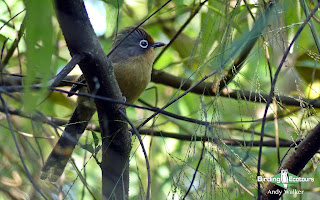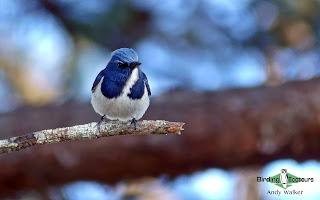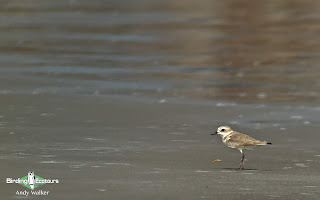It's always exciting finding something bright and colorful (don't worry, more on that in my next post...), however it's great when you find something uncommon, or rarely seen that you have to work on an ID for, such as an overwintering warbler.... Skip back to last week when I was in the north of Thailand.
Kicking round the rice paddies I heard a contact call - not unlike the contact call of plenty of non-breeding warblers and chats you hear out here in Thailand. But something just seemed a bit unusual about this one. A bit of pishing revealed an Acrocephalus warbler and I immediately knew it was something decent. It clearly wasn't Oriental Reed Warbler or Black-browed Reed Warbler (the two commonest members of the family in Thailand) which then left a handful of possibilities (some fairly straightforward to rule out) - Clamorous Reed Warbler, Blyth's Reed Warbler, Paddyfield Warbler, Manchurian (White-browed) Reed Warbler, Large-billed Reed Warbler, or Blunt-winged Warbler.
What was clear was that we needed to see the bird well, preferably get some photographs and then try and work out what it was. It was dusk and the sun was disappearing so time was of the essence, we had about 10 minutes of light left. With a bit of luck we were able to pish the bird into the open and got some photos before it got dark.
It wasn't going to be straightforward to ID the bird so once we hit the restaurant for dinner we started looking through the information we could get - a great website article on the "The Acrocephalus Issue (in Thailand)" (https://ayuwat.wordpress.com/tag/paddyfield-warbler/) and lots of help from my ringing/banding/birding mates back in the UK and New Zealand (thanks Tim, Ollie, and Matt!) we started reading through the details to see if the photos had captured enough to confirm the species ID one way or the other!
Luckily, one of the photos we got enabled us to see the all important wing structure/wing formula. So we started carefully reading the literature and came to the conclusion that our bird was Blunt-winged Warbler. I've annotated my friend Bills photo to show the key features we believe confirms this bird as such. Blunt-winged Warbler is considered an uncommon winter visitor to Thailand. In fact there were few records on ebird for the species in Thailand, and no photos, so we added our sighting and pictures there.
If anyone has any thoughts on this bird (agree/disagree with our thoughts) please let me know, would be really keen to get the thoughts of anyone more familiar with this species....
Kicking round the rice paddies I heard a contact call - not unlike the contact call of plenty of non-breeding warblers and chats you hear out here in Thailand. But something just seemed a bit unusual about this one. A bit of pishing revealed an Acrocephalus warbler and I immediately knew it was something decent. It clearly wasn't Oriental Reed Warbler or Black-browed Reed Warbler (the two commonest members of the family in Thailand) which then left a handful of possibilities (some fairly straightforward to rule out) - Clamorous Reed Warbler, Blyth's Reed Warbler, Paddyfield Warbler, Manchurian (White-browed) Reed Warbler, Large-billed Reed Warbler, or Blunt-winged Warbler.
What was clear was that we needed to see the bird well, preferably get some photographs and then try and work out what it was. It was dusk and the sun was disappearing so time was of the essence, we had about 10 minutes of light left. With a bit of luck we were able to pish the bird into the open and got some photos before it got dark.
The first pic we got of the mystery Acrocephalus warbler
It wasn't going to be straightforward to ID the bird so once we hit the restaurant for dinner we started looking through the information we could get - a great website article on the "The Acrocephalus Issue (in Thailand)" (https://ayuwat.wordpress.com/tag/paddyfield-warbler/) and lots of help from my ringing/banding/birding mates back in the UK and New Zealand (thanks Tim, Ollie, and Matt!) we started reading through the details to see if the photos had captured enough to confirm the species ID one way or the other!
Luckily, one of the photos we got enabled us to see the all important wing structure/wing formula. So we started carefully reading the literature and came to the conclusion that our bird was Blunt-winged Warbler. I've annotated my friend Bills photo to show the key features we believe confirms this bird as such. Blunt-winged Warbler is considered an uncommon winter visitor to Thailand. In fact there were few records on ebird for the species in Thailand, and no photos, so we added our sighting and pictures there.
Blunt-winged Warbler - key features for ID
If anyone has any thoughts on this bird (agree/disagree with our thoughts) please let me know, would be really keen to get the thoughts of anyone more familiar with this species....





















































